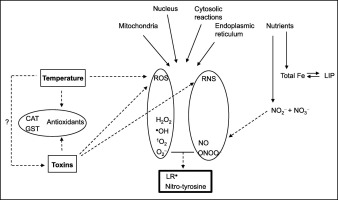当前位置:
X-MOL 学术
›
Comp. Biochem. Physiol. C Toxicol. Pharmacol.
›
论文详情
Our official English website, www.x-mol.net, welcomes your
feedback! (Note: you will need to create a separate account there.)
Possible role of seasonality and harmful algal blooms (HAB) on the oxidative and nitrosative metabolisms in hemocytes.
Comparative Biochemistry and Physiology C: Toxicology & Pharmacology ( IF 3.9 ) Pub Date : 2020-03-17 , DOI: 10.1016/j.cbpc.2020.108744 Paula Mariela González 1 , Susana Puntarulo 1
Comparative Biochemistry and Physiology C: Toxicology & Pharmacology ( IF 3.9 ) Pub Date : 2020-03-17 , DOI: 10.1016/j.cbpc.2020.108744 Paula Mariela González 1 , Susana Puntarulo 1
Affiliation

|
Bivalves survive to biotoxin consumption but their metabolism could be affected. The objective of this work was to study the oxidative and nitrosative changes in the hemocytes of the mussel Mytilus edulis platensis in different seasons, including spring, characterized by the appearance of harmful algal blooms (HAB). Reactive species generation rate (measured as the 2',7'dichlorofluorescein diacetate oxidation rate) was increased by 2.5- and 8.3-fold in hemocytes from spring and summer, respectively, as compared to winter samples. Neither total Fe nor labile Fe pool content was changed in the three seasons. Superoxide anion generation rate was 3-fold higher in spring as compared to winter and summer samples. Catalase content in spring cells were significantly higher as compared to winter (60%) and summer (3-fold increase) but glutathione-S-transferase activity only increased compared to summer season (125% increase). Lipid radical content in spring samples was 140 and 50% higher as compared to cells from winter and summer, respectively. Nitric oxide and nitro-tyrosine content were significantly higher in samples from spring as compared to values obtained either in winter or summer cells. Considering the aspects that influence metabolism, changes in temperature seem to mainly affect the oxidative over the nitrosative condition of the hemocytes. Nevertheless, HAB biotoxins seem as a contributing factor to affect not only reactive oxygen species generation, antioxidant activity and protein/lipid damage, but also the nitrosative metabolism. In this regard, the changes in the nitric oxide content are new and critical evidence that HAB-related toxins could affect reactive nitrogen species metabolism.
中文翻译:

季节性和有害藻华(HAB)对血细胞氧化和亚硝化代谢的可能作用。
双壳类可以生存以消耗生物毒素,但是它们的新陈代谢会受到影响。这项工作的目的是研究贻贝贻贝(Mytilus edulis platensis)在不同季节(包括春季)的血细胞的氧化和亚硝化变化,其特征是有害藻华(HAB)的出现。与冬季样品相比,春季和夏季的血细胞中反应物种的生成速率(以2',7'二氯荧光素二乙酸盐氧化速率衡量)分别增加了2.5倍和8.3倍。在这三个季节中,总铁和不稳定的铁库含量均未改变。与冬季和夏季的样品相比,春季的超氧阴离子生成速率高出三倍。与冬季(60%)和夏季(3倍增加)相比,春季细胞中的过氧化氢酶含量明显更高,但与夏季(125%升高)相比,谷胱甘肽-S-转移酶活性仅增加。与冬季和夏季的细胞相比,春季样品中的脂质自由基含量分别高140和50%。与冬季或夏季细胞中获得的值相比,春季样品中的一氧化氮和硝基酪氨酸含量明显更高。考虑到影响代谢的各个方面,温度的变化似乎主要影响血细胞亚硝化条件下的氧化作用。尽管如此,HAB生物毒素似乎不仅影响活性氧的产生,抗氧化活性和蛋白质/脂质损害,而且还影响亚硝化代谢。
更新日期:2020-03-19
中文翻译:

季节性和有害藻华(HAB)对血细胞氧化和亚硝化代谢的可能作用。
双壳类可以生存以消耗生物毒素,但是它们的新陈代谢会受到影响。这项工作的目的是研究贻贝贻贝(Mytilus edulis platensis)在不同季节(包括春季)的血细胞的氧化和亚硝化变化,其特征是有害藻华(HAB)的出现。与冬季样品相比,春季和夏季的血细胞中反应物种的生成速率(以2',7'二氯荧光素二乙酸盐氧化速率衡量)分别增加了2.5倍和8.3倍。在这三个季节中,总铁和不稳定的铁库含量均未改变。与冬季和夏季的样品相比,春季的超氧阴离子生成速率高出三倍。与冬季(60%)和夏季(3倍增加)相比,春季细胞中的过氧化氢酶含量明显更高,但与夏季(125%升高)相比,谷胱甘肽-S-转移酶活性仅增加。与冬季和夏季的细胞相比,春季样品中的脂质自由基含量分别高140和50%。与冬季或夏季细胞中获得的值相比,春季样品中的一氧化氮和硝基酪氨酸含量明显更高。考虑到影响代谢的各个方面,温度的变化似乎主要影响血细胞亚硝化条件下的氧化作用。尽管如此,HAB生物毒素似乎不仅影响活性氧的产生,抗氧化活性和蛋白质/脂质损害,而且还影响亚硝化代谢。











































 京公网安备 11010802027423号
京公网安备 11010802027423号